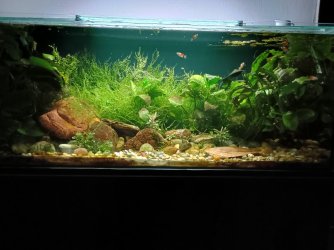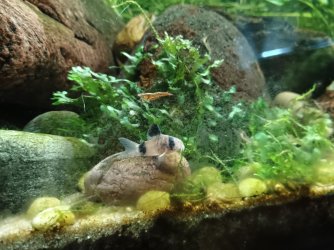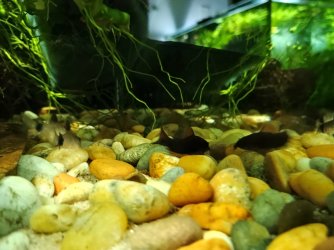Beastije
Fish Addict
Hi guys
for years I have struggled keeping corydoras, and I think a big part of the problem is my feeding. I am a sparse feeder and assumed they will get their fill of some things, but in community tanks, all the schooling and upper level fish are gluttons that are not afraid to dive under decor to gorge themselves (looking at you rummynose tetras and pearl gouramis). I also feed a lot of small live foods and I simply think they were not good at catching that.
I bought a new group of corydoras, because I missed them, and while the tank may not be the very best for them (has some pebbles, but the previous were all sand and they still died), I really need a detailed help how when and how much to feed them, ideally with pictures, like for a dummy
Here is what I have:
live food - microworms, (new) grindall worms culture, hatched bbs, occasional live mosquito larvae
frozen - cyclops, rotifers, daphnia, brine shrimp, mosquito larvae, blood worms, tubiflex, mysis
dried - hikari micro pellets, dennerle nanogran, sera vipan fry food, jbl novo tabs, local brand, vibra bites, pure spirulina tablets ( bought them for myself, yuck, fish appreciate them better), repashy super green, hikari cichlid gold, dried daphnia. None of these have insect content or any high percentage of it, cause fluval bug bites is impossible to buy here and the only other insect brand dry food has been out of stock for months.
The way I feed my community tanks is I usually combine smaller foods with larger foods. For example I will defrost cyclops and mosquito larvae, squirt the cyclops to entertain the faster feeders and target feed the mosquito larvae. This is how I did this in this particular tank before I added the corydoras. Or I would do the micro pellets and the vibra bites that would fall to the bottom. Or spirulina tablet, crushed to many smaller pieces, and a microworms/bbs.
The tank inhabitants are: 5 adult platy fish and many babies, 5 panda garra (that I target fed with a dripper the mosquito larvaes into their mouths to ensure they get something before the platies) and now 16 corydoras, a mix of 8 panda and 8 black Venezuelan
So please, tell me how often, how much and what to feed my new fish to also feed the other fish and to not have them eat it all, and to not be too small to fall too down between the pebbles...?
Thank you!
for years I have struggled keeping corydoras, and I think a big part of the problem is my feeding. I am a sparse feeder and assumed they will get their fill of some things, but in community tanks, all the schooling and upper level fish are gluttons that are not afraid to dive under decor to gorge themselves (looking at you rummynose tetras and pearl gouramis). I also feed a lot of small live foods and I simply think they were not good at catching that.
I bought a new group of corydoras, because I missed them, and while the tank may not be the very best for them (has some pebbles, but the previous were all sand and they still died), I really need a detailed help how when and how much to feed them, ideally with pictures, like for a dummy
Here is what I have:
live food - microworms, (new) grindall worms culture, hatched bbs, occasional live mosquito larvae
frozen - cyclops, rotifers, daphnia, brine shrimp, mosquito larvae, blood worms, tubiflex, mysis
dried - hikari micro pellets, dennerle nanogran, sera vipan fry food, jbl novo tabs, local brand, vibra bites, pure spirulina tablets ( bought them for myself, yuck, fish appreciate them better), repashy super green, hikari cichlid gold, dried daphnia. None of these have insect content or any high percentage of it, cause fluval bug bites is impossible to buy here and the only other insect brand dry food has been out of stock for months.
The way I feed my community tanks is I usually combine smaller foods with larger foods. For example I will defrost cyclops and mosquito larvae, squirt the cyclops to entertain the faster feeders and target feed the mosquito larvae. This is how I did this in this particular tank before I added the corydoras. Or I would do the micro pellets and the vibra bites that would fall to the bottom. Or spirulina tablet, crushed to many smaller pieces, and a microworms/bbs.
The tank inhabitants are: 5 adult platy fish and many babies, 5 panda garra (that I target fed with a dripper the mosquito larvaes into their mouths to ensure they get something before the platies) and now 16 corydoras, a mix of 8 panda and 8 black Venezuelan
So please, tell me how often, how much and what to feed my new fish to also feed the other fish and to not have them eat it all, and to not be too small to fall too down between the pebbles...?
Thank you!




